service indicator Oldsmobile Cutlass 1998 Owner's Manuals
[x] Cancel search | Manufacturer: OLDSMOBILE, Model Year: 1998, Model line: Cutlass, Model: Oldsmobile Cutlass 1998Pages: 348, PDF Size: 17.46 MB
Page 112 of 348
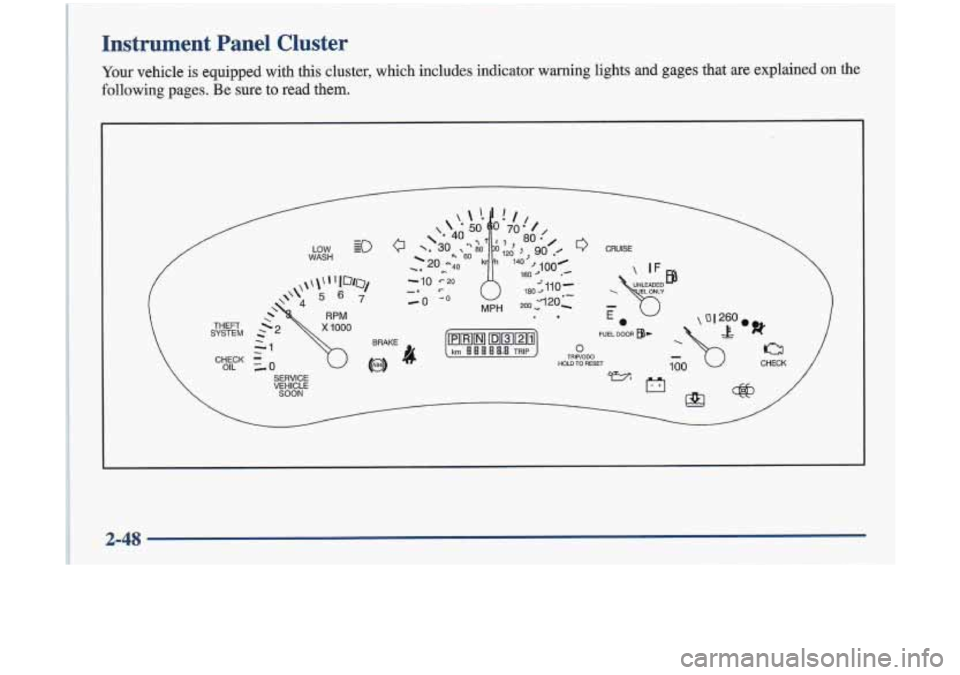
Instrument Panel Cluster
Your vehicle is equipped with this cluster, which includes indicator wdg lights and gages that me explained on the
following pages. Be sure to read them.
SYSTEM THEFT
CHECK OIL SERVICE
VEHICLE
SOON
CRUISE
2-48
Page 119 of 348
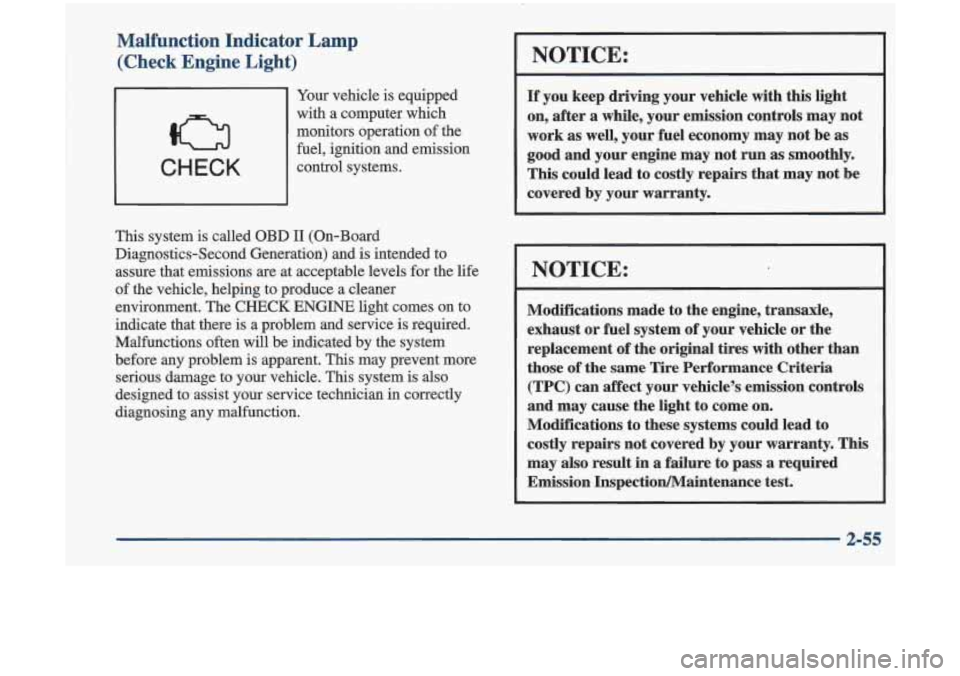
Malfunction Indicator Lamp (Check Engine Light)
CHECK
Your vehicle is equipped
with a computer which
monitors operation
of the
fuel, ignition and emission
control systems.
This system is called
OBD 11 (On-Board
Diagnostics-Second Generation) and is intended to
assure that emissions are at acceptable levels for the life
of the vehicle, helping to produce a cleaner
environment. The
CHECK ENGINE light comes on to
indicate that there is a problem and service is required.
Malfunctions often will be indicated by the system
before
any problem is apparent. This may prevent more
serious damage to your vehicle.
This system is also
designed to assist your service technician in correctly
diagnosing
any malfunction.
NOTICE:
If you keep driving your vehicle with this light
on, after
a while, your emission controls may not
work as well, your fuel economy may not be as
good and your engine may not run as smoothly.
This could lead to costly repairs that may not be
covered by your warranty.
Modifications made to the engine, transaxle,
exhaust or fuel system of your vehicle or the
replacement of the original tires with other than
those
of the same Tire Performance Criteria
(TPC) can affect your vehicle’s emission controls
and may cause the light to come
on.
modifications to these systems could lead to
costly repairs not covered by your warranty. This
may also result
in a failure to pass a required
Emission Inspection/Maintenance test.
Page 124 of 348
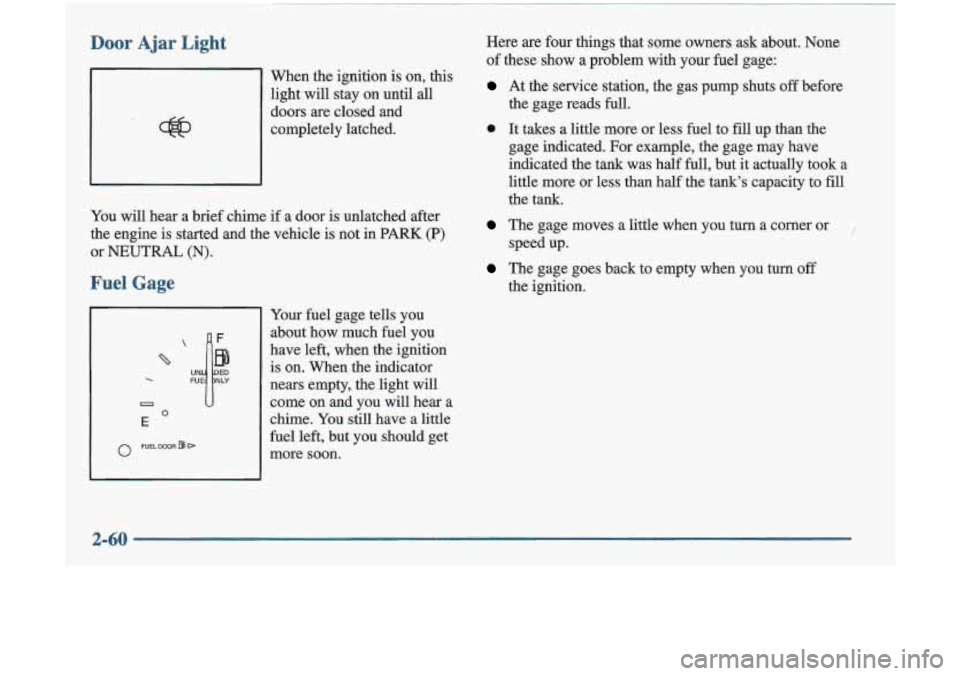
Door Ajar Light
When the ignition is on, this
light will stay on until all
doors are closed and
completely latched.
You will hear a brief chime if a door
is unlatched after
the engine is started and the vehicle is not
in PARK (P)
or NEUTRAL (N).
Fuel Gage
UN
0
E 0
0 FUELDOOR 83 D
Your fuel gage tells you
about how much fuel you
have left, when the ignition
is on. When the indicator
nears empty, the light will come on and you will hear a
chime. You still have a little
fuel left, but you should get
more soon. Here are four things that
some owners ask about. None
of these show a problem with your fuel gage:
At the service station, the gas pump shuts off before
0 It takes a little more or less fuel to
fill up than the
the gage reads full.
gage indicated.
For example, the gage may have
indicated the tank was half full, but it actually took a
little more
or less than half the tank’s capacity to fill
the tank.
The gage moves a little when you turn a corner or, I
The gage goes back to empty when you turn off
speed up.
the ignition.
Page 146 of 348
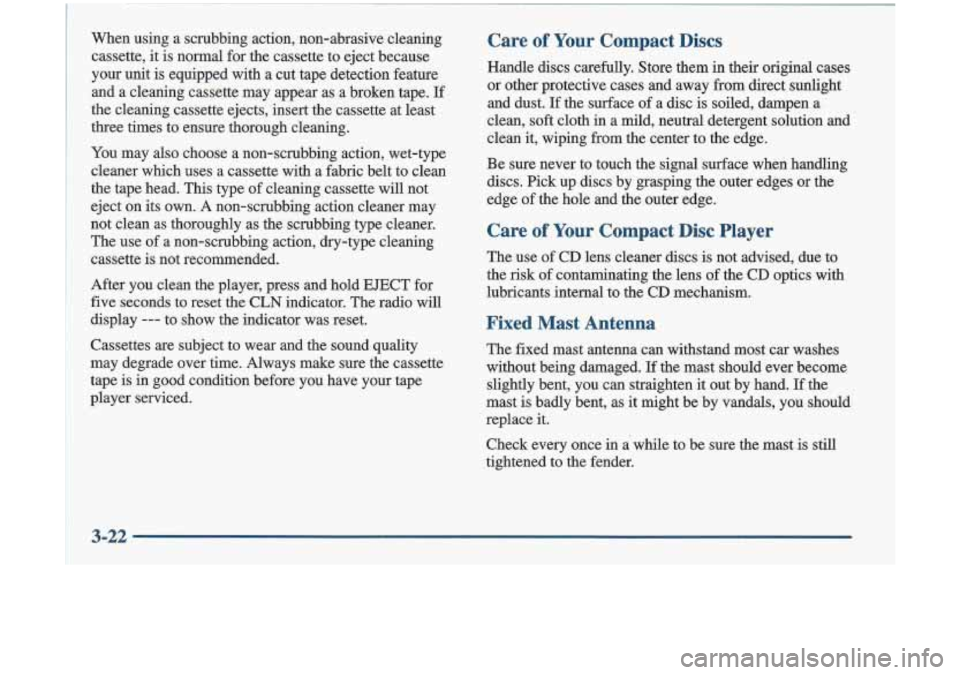
When using a scrubbing action, non-abrasive cleaning cassette, it is normal for the cassette to eject because
your unit is equipped with a cut tape detection feature and a cleaning cassette may appear as a broken tape.
If
the cleaning cassette ejects, insert the cassette at least
three times to ensure thorough cleaning.
You may also choose a non-scrubbing action, wet-type
cleaner which uses a cassette with a fabric belt
to clean
the tape head. This type of cleaning cassette will not
eject on its own. A non-scrubbing action cleaner may
not clean as thoroughly as the scrubbing type cleaner.
The use of a non-scrubbing action, dry-type cleaning
cassette is not recommended.
After you clean the player, press and hold EJECT for
five seconds to reset the CLN indicator. The radio will
display
--- to show the indicator was reset.
Cassettes are subject to wear and the sound quality
may degrade over time. Always make sure the cassette
tape is in good condition before you have your tape
player serviced.
Care of Your Compact Discs
Handle discs carefully. Store them in their original cases
or other protective cases and away Erom direct sunlight
and dust. If the surface
of a disc is soiled, dampen a
clean, soft cloth in a mild, neutral detergent solution and
clean it, wiping from the center to the edge.
Be sure never to touch the signal surface when handling discs. Pick up discs by grasping the outer edges or the
edge of the hole and the outer edge.
Care of Your Compact Disc Player
The use of CD lens cleaner discs is not advised, due to
the risk of contaminating the lens
of the CD optics with
lubricants internal to the CD mechanism.
Fixed Mast Antenna
The fixed mast antenna can withstand most car washes
without being damaged. If the mast should ever become
slightly bent, you can straighten it out by hand.
If the
mast is badly bent, as it might be by vandals, you should
replace it.
Check every once in a' while to be sure the mast is still
tightened to the fender.
3-22
Page 224 of 348
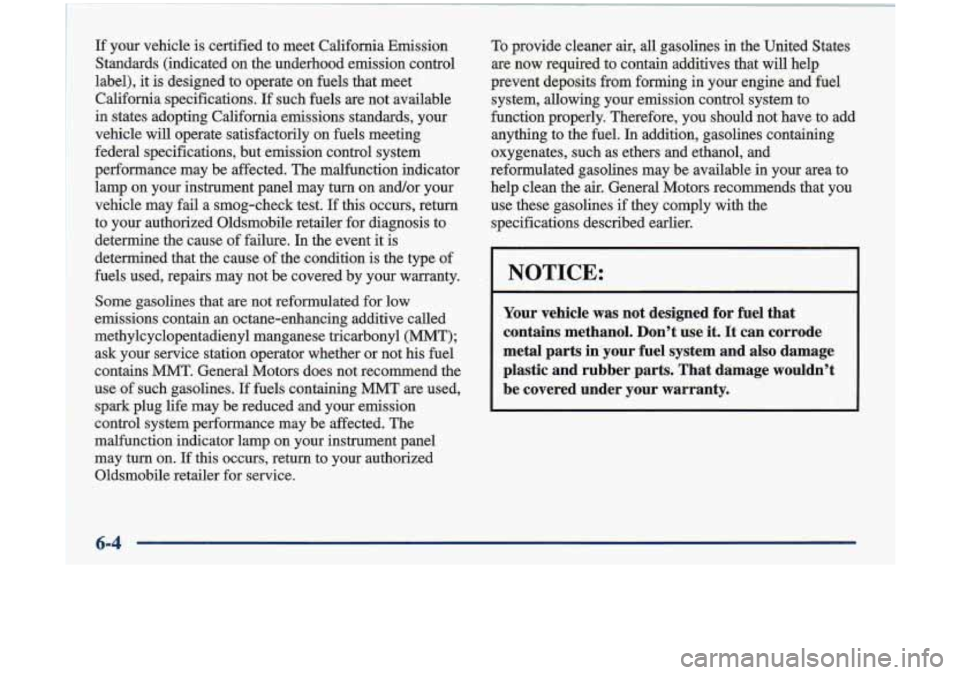
I If your vehicle is certified to meet California Emission
j Standards (indicated on the underhood emission control
label), it is designed to operate on fuels that meet
California specifications. If such fuels are not available
' in states adopting California emissions standards, your
1 vehicle will operate satisfactorily on fuels meeting
federal specifications, but emission control system
1 performance may be affected. The malfunction indicator
lamp on your instrument panel may turn on and/or your
vehicle may fail a smog-check test. If this occurs, return
to your authorized Oldsmobile retailer for diagnosis to
determine the cause of failure. In the event it is
1 determined that the cause of the condition is the type of
1 fuels used, repairs may not be covered by your warranty,
~ Some gasolines that are not reformulated for low
emissions contain an octane-enhancing additive called
methylcyclopentadienyl manganese tricarbonyl (MMT); ask your service station operator whether or not
his fuel
contains MMT. General Motors does not recommend the
~ use of such gasolines. If fuels containing MMT are used,
spark plug life may be reduced and your emission
control system performance may be affected. The
, malfunction indicator lamp on your instrument panel i may turn on. If this occurs, return to your authorized
i Oldsmobile retailer for service, To
provide cleaner
air, all gasolines in the United States
are now required to contain additives that will help
prevent deposits from forrning
in your engine and fuel
system, allowing your emission control system to
function properly. Therefore, you should not have to add
anything to the fuel. In addition, gasolines containing
oxygenates, such as ethers and ethanol, and
reformulated gasolines may be available in your area to
help clean the
air. General Motors recommends that you
use these gasolines
if they comply with the
specifications described earlier.
NOTICE:
Your vehicle was not designed for fuel that
contains methanol. Don't use it. It can corrode
metal parts in'your fuel system and also damage
plastic and rubber parts. That damage wouldn't
be covered under your warranty.
6-4
Page 246 of 348
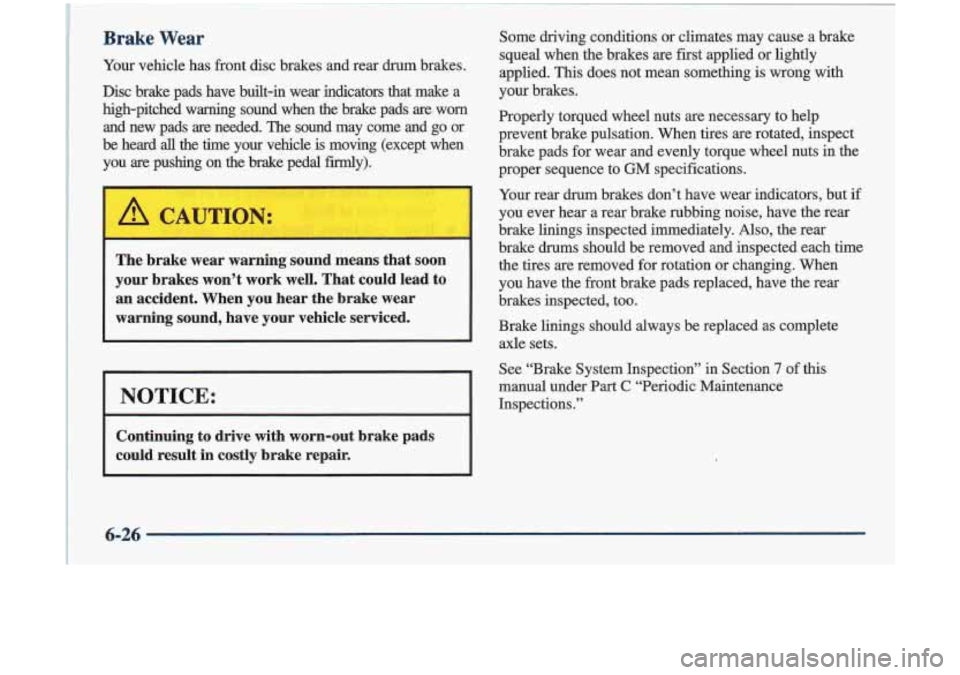
Brake Wear
Your vehicle has front disc brakes and rear drum brakes.
Disc brake pads have built-in wear indicators that make a
high-pitched warning sound when the brake pads are
worn
and new pads are needed. The sound may come and go or
be heard
all the time your vehicle is moving (except when
you
are pushing on the brake pedal firmly).
The brake wear warning sound means that soon
your brakes won’t work well. That could lead
to
an accident. When you hear the brake wear
warning sound, have your vehicle serviced.
I NOTICE:
~~ ~ ~~
Continuing to drive with worn-out brake pads
could result
in costly brake repair.
Some driving conditions or climates may cause a brake
squeal when the brakes are first applied or lightly
applied. This does not mean something is wrong with
your brakes.
Properly torqued wheel nuts are necessary to help
prevent brake pulsation. When tires are rotated, inspect
brake pads for wear and evenly torque wheel nuts in the
proper sequence to GM specifications.
Your rear drum brakes don’t have wear indicators, but
if
you ever hear a rear brake rubbing noise, have the rear
brake linings inspected immediately. Also, the rear
brake drums should be removed and inspected each time the tires are removed for rotation or changing. When
you have the front brake pads replaced, have the rear
brakes inspected, too.
Brake linings should always be replaced as complete axle sets.
See “Brake System Inspection” in Section
7 of this
manual under Part
C “Periodic Maintenance
Inspections.”
6-26
Page 337 of 348
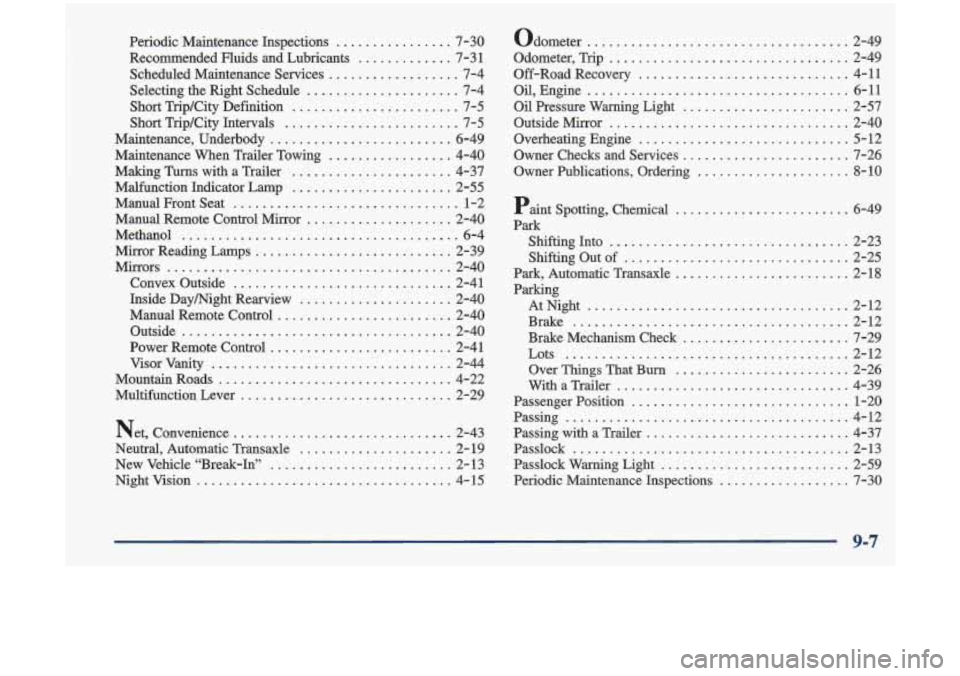
Periodic Maintenance Inspections ................ 7-30
Recommended Fluids and Lubricants
............. 7-3 1
Scheduled Maintenance Services .................. 7-4
Short Trip/City Definition
....................... 7-5
Short Trip/City Intervals
........................ 7-5
Maintenance. Underbody ......................... 6-49
Maintenance When Trailer Towing
................. 4-40
Making
Turns with a Trailer ...................... 4-37
Malfunction Indicator Lamp
...................... 2-55
Manual Front Seat
............................... 1-2
Manual Remote Control Mirror
.................... 2-40
Methanol
...................................... 6-4
Mirror Reading Lamps
........................... 2-39
Mirrors
....................................... 2-40
Convex Outside
.............................. 2-41
Inside Day/Night Rearview
..................... 2-40
Manual Remote Control
........................ 2-40
Outside
..................................... 2-40
Power Remote Control
......................... 2-41
Visor Vanity
................................. 2-44
MountainRoads
................................ 4-22
Multifunction Lever
............................. 2-29
Net. Convenience
.............................. 2-43
Neutral. Automatic Transaxle
..................... 2- 19
New Vehicle “Break-In”
......................... 2-13
Nightvision
................................... 4-15
Selecting the Right Schedule
..................... 7-4
Odometer
.................................... 2-49
Odometer. Trip
................................. 2-49
Off-RoadRecovery
............................. 4-11
Oil. Engine
.................................... 6-11
Oil Pressure Warning Light ....................... 2-57
Outside Mirror
................................. 2-40
Overheating Engine
............................. 5-12
Owner Checks and Services
....................... 7-26
Owner Publications. Ordering
..................... 8-10
Paint Spotting. Chemical ........................ 6-49
Park ShiftingInto
................................. 2-23
Shifting Out of
............................... 2-25
Park. Automatic Transaxle
........................ 2-18
Paxking
AtNight
.................................... 2-12
Brake
...................................... 2-12
Brake Mechanism Check
....................... 7-29
Lots
....................................... 2-12
Over Things That
Bum ........................ 2-26
WithaTrailer
................................ 4-39
Passenger Position
.............................. 1-20
Passing
....................................... 4-12
Passing with a Trailer
............................ 4-37
Passlock
...................................... 2-13
Passlock Warning Light
.......................... 2-59
Periodic Maintenance Inspections
.................. 7-30
Page 341 of 348
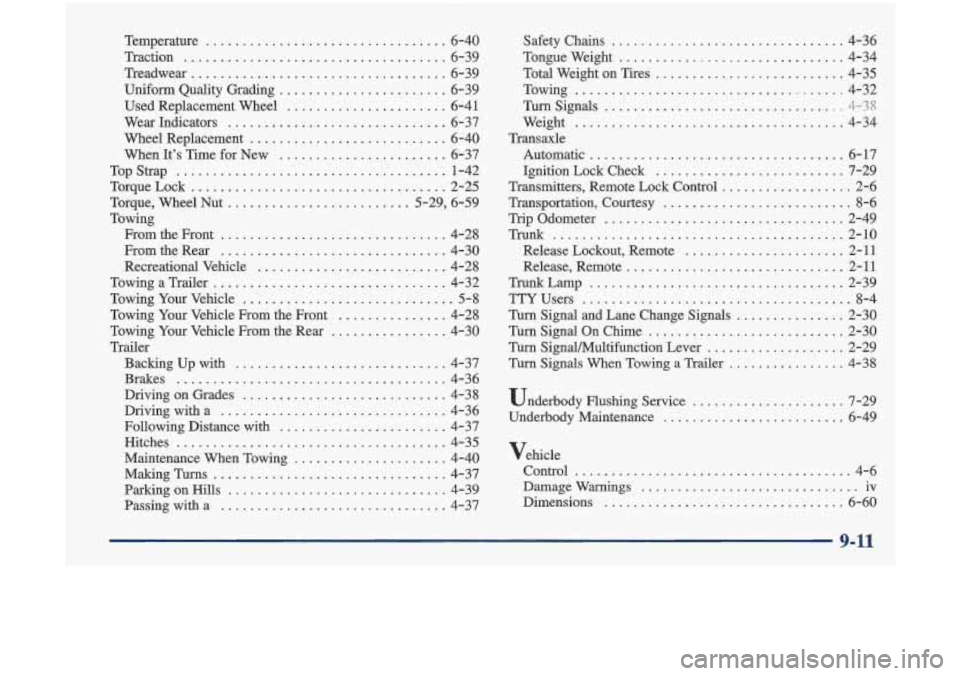
Temperature ................................. 6-40
Traction
.................................... 6-39
Treadwear
................................... 6-39
Uniform Quality Grading
....................... 6-39
Used Replacement Wheel
...................... 6-41
Wear Indicators
.............................. 6-37
Wheel Replacement
........................... 6-40
When It’s Time
for New ....................... 6-37
TopStrap
..................................... 1-42
Torque. Wheel Nut
......................... 5.29. 6.59
Towing FromtheFront
............................... 4-28
From the Rear
............................... 4-30
Recreational Vehicle
.......................... 4-28
TowingaTrailer
................................ 4-32
Towing Your Vehicle
............................. 5-8
Towing Your Vehicle From the Front
............... 4-28
Towing Your Vehicle From the Rear
................ 4-30
Trailer
Backing Up with
............................. 4-37
Brakes
..................................... 4-36
DrivingonGrades
............................ 4-38
Drivingwitha
............................... 4-36
Following Distance with
....................... 4-37
Hitches
..................................... 4-35
Maintenance When Towing
..................... 4-40
Making TWS
................................ 4-37
ParkingonHills
.............................. 4-39
Passingwitha
............................... 4-37
TorqueLock
................................... 2-25
Safety Chains
................................ 4-36
Tongueweight
............................... 4-34
Total Weight on Tires
.......................... 4-35
Towing
..................................... 4-32
Turn Signals
................................. 4-38
Weight ..................................... 4-34
Automatic
................................... 6-17
Ignition Lock Check
.......................... 7-29
Transmitters. Remote Lock Control
.................. 2-6
Transportation. Courtesy
.......................... 8-6
Trip Odometer
................................. 2-49
Trunk
........................................ 2-10
Release Lockout. Remote
...................... 2-11
Release. Remote
.............................. 2-11
TrUnkLamp
................................... 2-39
TTYUsers
..................................... 8-4
Turn Signal and Lane Change Signals ............... 2-30
Turn Signal On Chime
........................... 2-30
Turn Signal/Multifunction Lever
................... 2-29
Turn Signals When Towing a Trailer
................ 4-38
Underbody Flushing Service
..................... 7-29
Transaxle
Underbody Maintenance
......................... 6-49
Vehicle Control
...................................... 4-6
Damage Warnings
.............................. iv
Dimensions
................................. 6-60
9-11